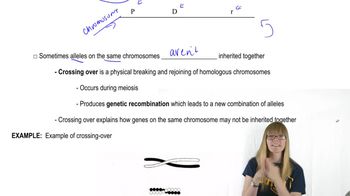In eukaryotic DNA, how does the role of H1 differ from the role of H3 in chromatin formation?
Table of contents
- 1. Introduction to Genetics51m
- 2. Mendel's Laws of Inheritance3h 37m
- 3. Extensions to Mendelian Inheritance2h 41m
- 4. Genetic Mapping and Linkage2h 28m
- 5. Genetics of Bacteria and Viruses1h 21m
- 6. Chromosomal Variation1h 48m
- 7. DNA and Chromosome Structure56m
- 8. DNA Replication1h 10m
- 9. Mitosis and Meiosis1h 34m
- 10. Transcription1h 0m
- 11. Translation58m
- 12. Gene Regulation in Prokaryotes1h 19m
- 13. Gene Regulation in Eukaryotes44m
- 14. Genetic Control of Development44m
- 15. Genomes and Genomics1h 50m
- 16. Transposable Elements47m
- 17. Mutation, Repair, and Recombination1h 6m
- 18. Molecular Genetic Tools19m
- 19. Cancer Genetics29m
- 20. Quantitative Genetics1h 26m
- 21. Population Genetics50m
- 22. Evolutionary Genetics29m
7. DNA and Chromosome Structure
Eukaryotic Chromosome Structure
Problem 4
Textbook Question
Describe the importance of light and dark G bands that appear along chromosomes.
 Verified step by step guidance
Verified step by step guidance1
Understand that G bands are produced using a staining technique called Giemsa staining, which highlights regions of chromosomes based on their DNA composition and chromatin structure.
Recognize that light G bands correspond to euchromatic regions, which are gene-rich and actively transcribed. These regions tend to have a higher GC content and are less condensed.
Identify that dark G bands correspond to heterochromatic regions, which are gene-poor and less transcriptionally active. These regions tend to have a higher AT content and are more condensed.
Learn that G banding is crucial for identifying chromosomal abnormalities, such as deletions, duplications, or translocations, by providing a visual map of the chromosome structure.
Appreciate that the pattern of light and dark G bands is unique to each chromosome, making it a valuable tool for karyotyping and diagnosing genetic disorders.
 Verified video answer for a similar problem:
Verified video answer for a similar problem:This video solution was recommended by our tutors as helpful for the problem above
Video duration:
3mPlay a video:
Was this helpful?
Key Concepts
Here are the essential concepts you must grasp in order to answer the question correctly.
Chromosome Structure
Chromosomes are long strands of DNA wrapped around proteins called histones, forming a compact structure that is essential for DNA packaging during cell division. The distinct banding patterns observed under a microscope, including light and dark G bands, arise from the differential staining of chromatin, which reflects the underlying organization of genes and regulatory elements.
Recommended video:
Guided course

Chromosome Structure
G Banding Technique
G banding is a cytogenetic technique that involves staining chromosomes with Giemsa dye, resulting in a characteristic pattern of alternating light and dark bands. The dark bands typically represent regions of heterochromatin, which are gene-poor and often contain repetitive sequences, while the light bands correspond to euchromatin, which is gene-rich and more actively transcribed.
Recommended video:
Guided course

Mapping with Markers
Genetic Mapping and Diagnosis
The patterns of G bands are crucial for genetic mapping and diagnosing chromosomal abnormalities. By identifying specific bands, researchers and clinicians can locate genes associated with diseases, detect chromosomal rearrangements, and assess the integrity of genetic material, aiding in the understanding of genetic disorders and cancer.
Recommended video:
Guided course

Mapping Overview
Related Videos
Related Practice
Textbook Question
657
views


